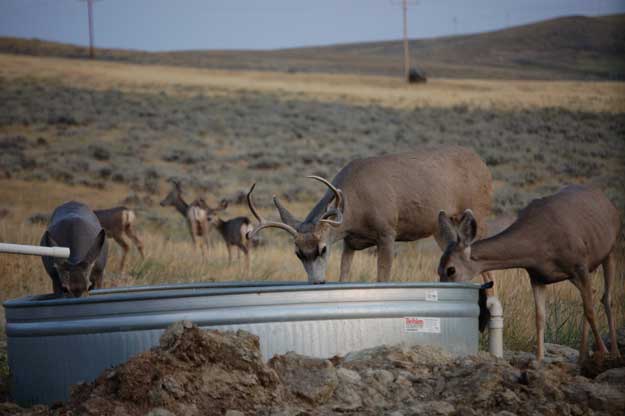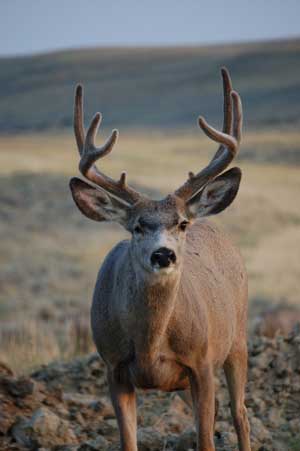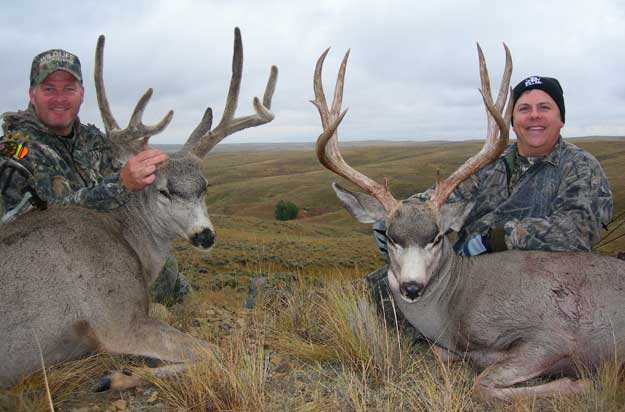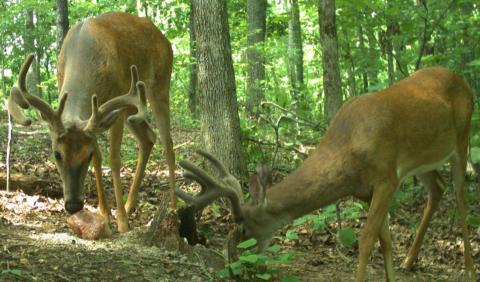Todd Amenrud | Mossy Oak BioLogic

A growing number of mule deer hunters are catching on to the fact that they can dramatically improve the quality of their herd and hunting opportunities by employing the same tried and true management methods of the QDMA. Just like whitetails, mule deer need food, water, cover and a spot where they are left alone. In recent years, I’ve been paying close attention to a ranch in Wyoming and how they have progressed. What they have learned over time about mule deer management only reinforces the spot-on philosophies of the QDMA.
Let’s be clear, even though I’m saying the same management philosophies may work, there are some great differences between the whitetails and mule deer. Whitetails are most definitely more adaptable, especially when it comes to dealing with human encroachment. Despite that, mule deer have a more rugged stomach. Mule deer can eat everything a whitetail can and then some. When it comes to their native habitat, man can do a lot to enhance a whitetails’ native environment. But with mule deer, their native habitat seems to be best if it’s just left alone by humans…that is unless thoughtful foresight is used to enhance habitat for mule deer.
I consider a big property east of the Mississippi to be a couple thousand acres, but out West that’s nothing. These ranches are vast, rugged properties frequently in excess of 20,000 or 30,000 acres and quite often working cattle ranches. This mule deer habitat can vary from rolling sage covered hills and conifer forest edges to mountainous terrain or even a desert environment.
One particular ranch east of the Bighorn Mountains is home to hundreds of healthy pronghorn and some of the best mule deer hunting I can imagine, at least the best I’ve ever seen. It’s owned by Bill Mankin who has help managing the property from his nephew Ryan Routier. These guys are implementing the same philosophies that work on the whitetails of the East with a slightly different approach. By letting young bucks live and providing quality habitat and food this place has become a mule deer paradise.
Mule deer typically have larger home range sizes than their eastern cousins. But why would that be the case? Most likely it’s simple. To find the basic necessities of food, water and cover at various times of the year, they need to travel further in their often barren home ranges. But what happens when you give them everything they need in a smaller area? Their home range shrinks. If you look after their basic food and water needs, keep up their natural habitat and don’t pressure them off of their pasture, they will confine their movements to a much smaller home range which makes hunting them easier.
 Mule deer densities can vary widely across their range. Productive habitats such as the Mankin ranch can support comparatively dense populations, where in other areas they are sparse or have disappeared completely. Mule deer numbers peaked in the 1960s and declined sharply throughout the last half of the 20th century. Most believe the reason for the decline has been caused by several factors including human-caused habitat loss like degradation, or fragmentation, diseases such as CWD and epizootic hemorrhagic disease (EHD), and weather events including drought and severe winters. So sound “trigger finger” management is essential and a little luck once in a while sure doesn’t hurt either.
Mule deer densities can vary widely across their range. Productive habitats such as the Mankin ranch can support comparatively dense populations, where in other areas they are sparse or have disappeared completely. Mule deer numbers peaked in the 1960s and declined sharply throughout the last half of the 20th century. Most believe the reason for the decline has been caused by several factors including human-caused habitat loss like degradation, or fragmentation, diseases such as CWD and epizootic hemorrhagic disease (EHD), and weather events including drought and severe winters. So sound “trigger finger” management is essential and a little luck once in a while sure doesn’t hurt either.
Development and degradation of their habitat can hurt mule deer populations deeply. It depends upon what type of habitat as to how it may impact them. For example, many deer herds migrate to traditional winter ranges where they have thermal cover, less snow and a more dependable food source. But winter ranges tend to be smaller areas, forcing deer to congregate at much higher densities. That means a comparatively small loss of winter range can be more devastating as a much larger impact on summer range. In addition, developing areas that disturb an established migration route can endanger a large segment of the mule deer herd.
In my view, one of the most limiting factors is rainfall. This affects both, food and available natural water sources. During spring and into summer, mule deer will intake much of their water through the plants they eat, but during the remainder of the year and when does are lactating, a reliable water source is very important. Unless you irrigate, you obviously can’t do better than Mother Nature’s moisture for the food source, but a couple windmills or a pond dam here and there can be all you need for a water source. These water supplies that were put in place originally for cattle are sometimes literally life-savers for the mule deer during a dry year.
The rainfall dramatically affects the mule deer’s food sources both planted food plots and natural foods. This particular ranch receives enough rain to grow good annual crops, and even a sufficient amount to sustain deep-rooted perennials like alfalfa and chicory without having to irrigate. I have consulted on ranches in Colorado, Wyoming and Nebraska that receive as little as 12 inches of annual rainfall. In this case, you’re not going to grow pretty, picture-perfect plots, but you can still yield tons of food for your local mule deer herd.
Mule deer feed mainly on shrub leaves, buds and stem-tips from late summer through fall and winter. During spring through early summer, they rely more on forbs and grasses, which are green, succulent, and high in protein at that time. Because of the often poor quality of the native food sources, food plots can have a huge impact on herd health and carrying capacity.
In cases of low rainfall like this, we have a food plot plan that works well. You can never predict Mother Nature, but most years we succeed. We stick to growing annuals during the times when the topsoil moisture is present and choose our crops carefully. That means growing crops like Lablab and BioMass All Legume planted during the spring. Then in anticipation of the "fall rains" we plant fast growing, quick yielding blends like Full Draw, Outfitter’s Blend, Trophy Oats, Last Bite and various cereal grains. You want crops that germinate quickly and will do well if you only receive minimal rainfall.
In my view, the brassica is one of the best whitetail food sources available. Many are catching on that they work just as well for mule deer. Brassicas will help bring your mule deer into the rut in tip-top shape and in northern areas of their range, where corn isn’t an option like it is for whitetails, can help sustain them through the cold winter months.
On my last trip to the Mankin Ranch my brother-in-law Mike Berggren and I each harvested mature mule deer bucks on the same plot of Outfitter’s Blend mixed with barley. This was an incredible draw for the deer and Mike and I routinely had 30 to 50 deer in the 20-acre plot each afternoon. The cereal grains will also provide excellent energy coming into the rut.

Rainfall makes such an impact on “leader growth,” which is the new growth on shrubs and other browsed plants from the current growing season that browsing animals like antelope and mule deer survive on through winter. Shrubs like sagebrush, mountain mahogany and bitterbrush are browsed through the winter by both mule deer and pronghorn.
Mule deer habitat can also be improved through habitat modifications. Certain agricultural procedures will benefit mule deer by increasing shrub productivity and increasing the forbs and grass components of the understory. Mechanical and chemical treatments, prescribed fire, and seeding can enhance and/or restore mule deer habitats.
Herd management is where I learned quite a lot from Bill Mankin and Ryan Routier. Bill is a lifelong student of mule deer. This cowboy loves to observe big mule deer bucks every chance he gets, which usually means when he isn’t winning another team roping event. Ryan has guided people on trophy mule deer hunts in numerous states throughout the West.
In this unforgiving landscape, doe harvest doesn’t seem to be as important to them as it would be with a typical whitetail farm east of the Mississippi. Don’t get me wrong, the density and buck to doe ratio is important, but with the harsh conditions and increased natural predation in these remote areas and the fact that they harvest very few bucks off of the property, I would put their buck to doe ratio at darn near 50:50. An aggressive doe management plan isn’t required.
Predator management is a part of their routine. Mule deer are preyed upon by mountain lions, coyotes, black bears, grizzly bears, bobcats and wolves. This ranch has to deal mainly with coyotes and bobcats, but these crafty carnivores can have a great impact on fawn recruitment in the spring of the year so they must stay on top of the numbers.
There is also competition for prime areas between elk and mule deer. Guess who wins that battle? Other species may overlap as well including whitetails and pronghorn. So in addition to managing your deer numbers, regulating your elk or other large game animals can also have a direct effect on your mule deer density.
Mankin and Routier are very selective about which bucks are shot, and in my opinion, just like a good whitetail manager, they base their harvest decisions upon age not antler score. With the help of archery rep and good friend Bruce Hudalla, they are learning how trail cameras can significantly help with herd management and targeting specific bucks. Before Mike and I arrived in camp we were shown pictures of specific bucks, which helps significantly with the decision of whether or not to shoot when the moment of truth arrives. I killed a whopper 4x5 that was five years old and Mike killed a six or seven-year-old buck with battle scars that showed his old age. We had a chance to observe these bucks before we took the shot, so we knew what we were going to do before the opportunity presented itself.
Natural Habitat is taken care of in this area by simply leaving it alone. Sure, there are cattle grazing in selected pastures and the occasional oil well, but the deep sage brush covered draws and thick greasewood entangled creek bottoms make excellent “bedrooms” for these mule deer.
For a treestand hunter from the Midwest, the change of being able to see for miles and miles is a remarkable swap once in a while. To see 100 pronghorn on a sage covered hill or 50 mule deer in a food plot is something every hunter should experience at least once. And to answer the question, “Can mule deer be managed effectively?” The answer is absolutely yes.



























